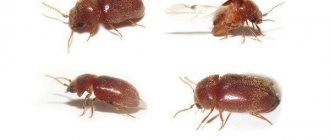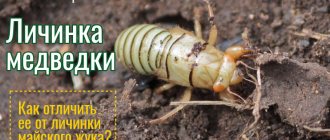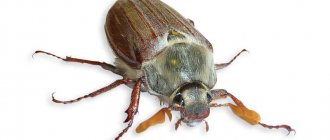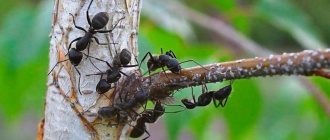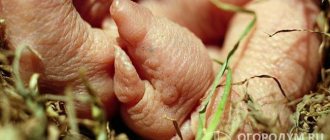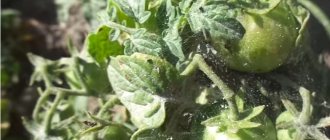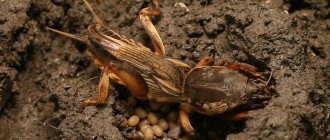Home » Useful information
Olga Polyakova 05/19/2020
44384 Views 1 comment
A pest like the mole cricket is unique in its own way. Firstly, this is a creature capable of moving in all available ways: from underground to air; and even in entering this pest is very dexterous and fast.
Secondly, an insect can eat almost any food of plant origin; Although giving preference to tuberous crops, the mole cricket, in their absence, perfectly adapts to the diet that its habitat provides it with.
No plant is immune from this pest. And finally, thirdly, it has excellent adaptability and high survivability. In addition, the insect is very cautious and timid.
Medvedka: description and damage caused
Mole crickets are large burrowing insects that form a separate family. They are 5-9 cm long and live in burrows they dig. The appearance of the pest is very characteristic; it is difficult to confuse it with any other insect.
Medvedka
The fight against mole crickets on the site is, first of all, a strategic fight. Leading a secretive lifestyle, the insect always finds options on how to survive in the conditions of certain countermeasures, therefore, in order to defeat this pest, just one method of exterminating it is not enough; it is necessary to use several.
The insect's forelimbs are seriously modified and adapted for digging. The chest shell is thick and very durable. In case of danger, the insect's head is completely retracted under it.
The abdomen is long, approximately 2-3 times larger than the cephalothorax, however, it is practically not protected by a chitinous layer. The body color of a mole cricket is almost always the same – it is dark brown on top and light brown or olive underneath.
A mole cricket protecting its clutch
The insect is a pest of many crops. All tuberous, root, berry and fruit crops are included in the list of the mole cricket’s diet. If there are no root crops, the pest moves on to rhizomes and bulbs.
In particularly serious cases, it even damages the root system of not only fruit trees, but also non-fruit trees.
Mole cricket larva
Signs of the appearance of a mole cricket on the site are its passages, burrows and loud evening chirping, reminiscent of the sounds made by crickets. Which, however, is not surprising, the families of Medvedkov and Real Crickets are very close relatives.
Mole cricket moves after precipitation
Where does the pest live?
The insect lives in the ground and needs a lot of space, so there is no need to be afraid that the mole cricket will end up on the balcony or in the house. Even if she ends up there, she is unlikely to start eating houseplants or live under the bed. Creating corridors in the earth is its natural environment. The insect loves a fertile substrate, moist and humus. It often appears where the soil is fertilized with natural manure or compost. Therefore, he is not interested in house plants.
You can often find mole crickets in a greenhouse, hotbed, on the lawn, in vegetable gardens - wherever the soil is light, fertile, well loosened, with a high content of humus. Sometimes insects live in the compost heap. They can be brought into the garden during the process of adding compost to the beds.
How do you know that mole crickets have appeared in the garden?
It is difficult to fight a mole cricket; its nest is difficult to find. It is located underground.
The presence of insects can be detected by the appearance of plants. If several plants have been grafted in one place, and their roots are clearly gnawed and have round bite marks, most likely this was done by a mole cricket.
The pest is not picky and eats almost any garden plant. It gnaws almost all roots, tubers, and rhizomes.
Application of chemistry
Sealing mole cricket burrows with cotton wool
The chemical industry produces a fairly large number of drugs used to kill mole crickets.
Almost all of them are broad-spectrum insecticides that can also destroy the following species:
- larvae of May beetles and bronze beetles
- wireworm larvae and adults
- black garden ants (breeding aphids and mealybugs)
A description of the drugs and the features of their use is given in the table:
| A drug | Active substance | How to use |
| Medvetox | Spectracid 25E | It is a red granular powder. Harmless to plants and many other species of earth animals, in particular earthworms. Placed between rows in long furrows up to 5 cm deep. Validity period is about 15 days. The action begins a few hours after application. |
| Anti-Medvedka | Imidacloprid | Large and small white granules. Consumption - no more than 20 g per 1 hundred square meters. Placed on the surface between the beds during planting. |
| Medvecid | Imidacloprid | Small purple granules. They are located in furrows no more than 3 cm deep between rows. The distance between the granules is 50-100 cm. Consumption is 10g per 1 sq. m. |
Rembek | Imidacloprid and chlorpyrifos | Presents a malfunctioning strong-smelling bait. Consumption - no more than 25 g per 1 hundred square meters. Baits are placed in and around holes. |
| Boverin | Beauveria bassiana spores | A suspension is made from the substance, which is applied to plants and around mole cricket burrows. The spores of the fungus, falling on the skin of an insect, begin to germinate inside its body, which leads to death within a few days. Repeated treatment is carried out after 1-2 weeks. |
| Phenaxin-plus | Phosphothion | It is a strong-smelling white-yellow granule. Their laying is carried out at the stage of sowing seeds. Repeated treatment - 3 weeks after sowing (duration of the drug); in this case, the granules are simply placed near the stems. |
Any of the listed drugs (except Boverin) can be used in a mixture with edible bait - oatmeal, buckwheat or pearl barley porridge. Sunflower oil is also added to the bait. In the evening, the resulting mixture is laid out near the bear's burrows in the amount of 10-15 g per hole.
In addition, to combat mole crickets, acetylene is used, which is poisonous for the insect. To do this, 5 g of calcium carbide is placed in each hole and all holes are sealed with cotton wool or soft cloth, covered with earth on top.
When the substance reacts with water (in the form of rain or irrigation water), it decomposes into acetylene, which fills the mole cricket's burrows and passages. The gas quickly kills the insect.
Kerosene can also be used against mole crickets. However, this comes with some problems: due to the relatively high toxicity of the drug, it is not recommended for use in large quantities. You can fill no more than 1-2 holes on the site with kerosene; Up to 50 ml of substance is consumed for each hole.
How to get rid of mole crickets forever using ammonia
The smell of ammonia repels cabbage grass. Ammonia (10% ammonia, 3-4 tsp) is diluted in 10 liters of water. In order not to harm the plants, this concentration will be sufficient. Young seedlings are watered with the mixture at the rate of 0.5 liters per plant. The smell of the drug disappears quickly, so this procedure is repeated once a week. If the leaves on the plants turn yellow, stop watering with the product. In order not to harm the seedlings, pieces of fabric are soaked in ammonia and laid out between the plants.
Repellent methods
Folk method of struggle
The mole cricket, like all insects, is able to distinguish odors well. There are odors that are both pleasant and unpleasant for insects. The list of the latter is quite extensive - it includes both the smells of certain substances and the smells of certain plants.
Therefore, to avoid the appearance of an uninvited insect, it is recommended to use the following methods:
1 In the spaces between the rows, as well as along the perimeter of the site, you can plant plants that are “unpleasant”
- calendula
- marigold
- chrysanthemums
2 To protect potato crops from insects, after flowering, you need to place branches of coniferous plants between the rows:
- fir
- ate
- pine trees
Mulching with pine needles between rows
3 Make stakes up to 40 cm long from freshly cut aspen or alder branches (at least 30 mm thick). They must be buried at a distance of at least 25 cm at a distance of no more than 1.5 m from each other. In this case, the bark should remain on the stakes. The stakes should be renewed as they dry out.
4 It is recommended to fill the mole cricket’s passages with a solution of onion peels
5 When planting plants, it is recommended to add a peeled clove of garlic under each plant.
6 Instead of garlic, you can put small fish (not salted, of course) under each plant.
7 Greenhouses should be fenced around the perimeter with furrows 5-10 cm deep, into which pour naphthalene or sand moistened with kerosene
8 For root plants (beets, carrots, parsley, etc.), it is recommended that the first watering be done with a solution of iodine in water (10 drops of iodine are dissolved in 5 liters of water)
Agrotechnical techniques
Agrotechnical practices include:
- autumn plowing (deep digging of the site in the fall);
- spring digging;
- removal of weeds;
- regular inspection of the site.
In early spring, in weed-free beds prudently dug up in the fall, the passages of cabbage grasses are very clearly visible. During this period, it is easy to collect pests manually; it is enough to dig to a depth of 25–30 cm in the immediate vicinity of the entrance hole. The chance of getting caught by an insect is quite high. But in untreated areas it is almost impossible to detect and get rid of mole crickets.
Biological methods
The mole cricket has many natural enemies. First of all, these are birds. The greatest damage to the population is caused by rooks, crows, starlings and even ordinary chickens.
Hoopoe catching a mole cricket
It is recommended to let the latter out into the garden from time to time. Naturally, this needs to be done at a time when the chickens themselves cannot harm the crops; for example, before the beginning of periods of active growth of young plants, fruiting, harvesting, etc. Chickens are able to perfectly find mole crickets and their larvae and destroy them.
In addition, hedgehogs, lizards, shrews, moles and ants are involved in the destruction of mole crickets. Attracting, for example, a hedgehog to your garden is very simple - just place a saucer of milk in the garden every evening.
With birds, everything is also relatively simple - birdhouses or nest boxes on the site will significantly improve the situation with any harmful insects, including mole crickets.
There is also a highly specialized enemy of the mole cricket – the Larra anathema wasp. This type of wasp lays eggs exclusively in mole crickets, where their development occurs. After the larva matures, it leaves the host, who soon dies.
Larra anathema wasp, a natural enemy of the mole cricket
This insect does not pose any harm to humans, plants and other inhabitants of the garden, therefore, if you encounter this wasp, there is no need to destroy it. The wasp is quite widespread in the south of the European part of Russia, in the Krasnodar Territory, as well as in Ukraine, Moldova, and Georgia.
If the issue of counteracting mole crickets is very pressing, you can also try to use wasps to combat them. Legumes are used to attract wasps. larra” is best attracted to a plant called “partridge pea”.
How are insects dangerous for plants?
Harm in the garden from the mole cricket is manifested in the death of all cultivated plants encountered along its path. Moving through underground passages, the pest gnaws on roots, tubers, foliage and seeds of various crops. The insect can indiscriminately damage both adult plantings and young seedlings. But this parasite is not interested in weeds.
Most often, vegetables such as cucumbers, tomatoes, peppers, eggplants, cabbage, legumes, cereals, strawberries and other berries, as well as flower perennials, suffer from mole crickets. The parasite's favorite food is the pulp of root vegetables - potatoes, radishes, carrots and beets.
Due to the suitable optimal conditions for life, the mole cricket has chosen greenhouses and hotbeds. Damaged plants die quickly before reaching maturity.
Prevention of occurrence
A typical insect light trap used to control mole crickets
To protect the area from the appearance of unwanted guests in the form of mole crickets, a number of measures should be taken. Most of them are in the nature of general recommendations carried out when counteracting various pests.
Such measures include:
1 Planting the repellent plants described earlier on the site
2 Digging of areas along the perimeter with furrows with naphthalene or special means Medvetsid
3 Systematic inspection of all types of soil and fertilizers brought to the site (manure, humus, black soil, sand, etc.) to search for mole crickets, their eggs and larvae. Approximately a third of the cases of pest penetration into plots occur with imported soil material
4 Regular weeding and loosening of the soil. Weed removal
5 During the mole cricket’s flight (mid-to-late May), use specialized light traps that are suspended above containers (you can use a regular basin) with a water-kerosene composition. Insects, flying towards the light, stumble upon a trap and fall into a basin, where a layer of kerosene located above the water envelops their bodies, causing suffocation and death
6 Since the mole cricket lives exclusively in acidic soils, it is recommended to carry out annual deacidification of the site by adding dolomite flour or lime to the soil.
At the same time, it must be said right away that some methods of preventing the appearance of pests are not applicable to mole crickets. For example, burying metal mesh around the perimeter of the site, which is very effective against moles, will not have any effect on mole crickets.
Firstly, mole crickets are somewhat smaller than moles, and secondly, unlike moles, they can move both on the ground and in the air.
Traps
There are many types of traps that can be used to easily catch various harmful creatures, including mole crickets. In most cases, they are installed in the summer or before spring weeding.
How to use the most effective trap:
- A hole is dug in the garden bed, 15–20 cm deep.
- A plastic bottle (for example, made of polycarbonate) is placed in it.
- The container is buried, leaving a neck on the surface, which should be flush with the ground.
- 100 ml of sugar syrup, beer or honey dissolved in water is poured into the bottle.
- The bait will attract mole crickets, which will penetrate inside the container.
- They will not be able to get out of the trap.
